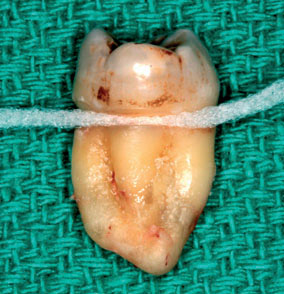(Pls send your suggestions!)
Salas ML, McClellan AC, MacNeill SR, Satheesh KM, Cobb CM.
Interproximal cervical lesions caused by incorrect flossing technique.
Int J Dent Hyg. 2012 May;10(2):83-5.
This case report describes an interproximal cervical lesion caused by the incorrect use of dental floss. A 58-year-old man who was asymptomatic, presented with unusual notch-like cervical lesions. After clinical and radiographical examinations, it was concluded that the aetiology of these lesions was an incorrect flossing technique. The treatment plan included extraction of maxillary 3rd molars and re-education of the patient in oral hygiene technique. CONCLUSION: These lesions are irreversible and often go undiagnosed; therefore, it is important for the clinician to be familiar with the clinical presentation and aetiology.
doi: 10.1111/j.1601-5037.2011.00524.x. Epub 2011 Aug 15. PubMed PMID: 21843209.
For the PDF, click here
Image on right shows one of 2 healthy teeth that were taken as souvenirs.

Floss cleans teeth where brushing can't!
Plaque-Removal Efficacy of Four Types of Dental Floss
Géza T. Terézhalmy,* Robert D. Bartizek,† and Aaron R. Biesbrock†
*University of Texas Health Science Center at San Antonio Dental School, San Antonio, TX.
†Health Care Research Center, Procter & Gamble, Mason, OH.
Correspondence: Dr. Aaron R. Biesbrock, Procter & Gamble, 8700 Mason-Montgomery Rd., Mason, OH 45040-9462. Fax: 513/622-0560; e-mail: biesbrock.ar@pg.com.
Background: Effective plaque removal is essential for gingival health, and dental floss is used to augment plaque removal achieved with a toothbrush.
Methods: This randomized, controlled, examiner-masked, five-period crossover study examined plaque removal in 25 subjects following single use with an American Dental Association reference manual toothbrush alone and in combination with four floss products: three traditional (unwaxed, woven, and shred-resistant) and one powered flosser. Plaque was scored before and after brushing for 1 minute. The Rustogi modified Navy plaque index was used to focus scores on tooth areas contacted during the proper use of dental floss.
Results: Mean plaque reductions (baseline minus postbrushing) in floss contact areas were as follows: 0.181 with the toothbrush alone; 0.228, 0.217, and 0.210 for the toothbrush in combination with the three traditional flosses, unwaxed, woven, and shred-resistant, respectively; and 0.252 for the toothbrush plus powered flosser. No statistically significant differences were found between the three traditional floss treatments. All four floss treatments showed greater (P <0.05) mean plaque removal than the toothbrush alone. Mean plaque removal with the powered flosser combination was greater than for the woven combination and shred-resistant combination (both P ≤0.006) and fell just short of significance compared to the unwaxed combination (P = 0.051).
Conclusions: All four floss products in combination with a manual toothbrush removed plaque significantly better than the toothbrush alone. Among floss types, there was evidence of superiority for the powered flosser, but there were no significant treatment differences between the three traditional floss products.
Flossing cleared out bad bacteria around teeth in just 2 weeks when 1 of 2 twins flossed!
Treatment Outcomes of Dental Flossing in Twins: Molecular Analysis of the Interproximal Microflora
Patricia M.A. Corby,* Aaron Biesbrock,† Robert Bartizek,† Andrea L. Corby,‡ Robin Monteverde,§ Rafael Ceschin,§ and Walter A. Bretz*
*Departments of Periodontics and Cariology, New York University College of Dentistry, New York, NY.
†Procter & Gamble, Cincinnati, OH.
‡Twins Institute for Genetics Research, Montes Claros, Minas Gerais, Brazil.
§School of Arts and Sciences, University of Pittsburgh, Pittsburgh, PA.
Correspondence: Dr. Patricia M.A. Corby, Bluestone Center for Clinical Research, New York University College of Dentistry, 345 E. 24th St., New York, NY 10010. Fax: 212/995-4843; e-mail: patricia.corby@nyu.edu.
Background: The purpose of this study was to assess the effects of dental flossing on the microbial composition of interproximal plaque samples in matched twins.
Methods: The study was a two-treatment, examiner-masked, randomized, parallel-group, controlled study. Fifty-one twin pairs between 12 and 21 years of age were randomized to a 2-week supervised and unsupervised treatment regimen consisting of tongue brushing and toothbrushing or tongue brushing and toothbrushing plus flossing. The reverse-capture checkerboard hybridization assay was used to assess levels (abundance) of 26 microbial species in interproximal plaque samples collected from six sites per subject. An integrative computational predictive model estimated average changes in microbial abundance patterns of selected bacterial species from baseline to 2 weeks by comparing treatment groups.
Results: After the 2-week study period, putative periodontal pathogens and cariogenic bacteria were overabundant in the group that did not floss compared to the group that performed flossing. Those included Treponema denticola, Porphyromonas gingivalis, Tannerella forsythia (previously T. forsythensis), Prevotella intermedia, Aggregatibacter actinomycetemcomitans (previously Actinobacillus actinomycetemcomitans), and Streptococcus mutans. Microbial species that are not consistent with the development of periodontal disease or dental caries were overabundant in the group that did floss compared to the non-flossing group.
Conclusion: In a well-matched twin cohort, tooth and tongue brushing plus flossing significantly decreased the abundance of microbial species associated with periodontal disease and dental caries after a 2-week program.